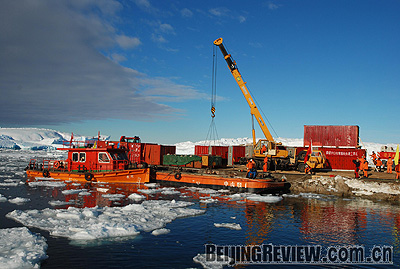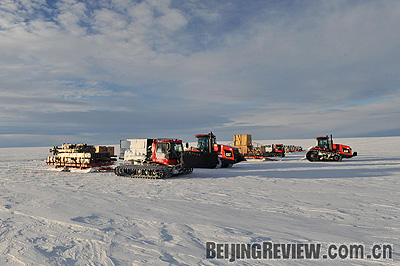| Exactly 17,501.949 km-that's the distance from Beijing to Changcheng (literally meaning the Great Wall) Station, the first little piece of China on the continent of Antarctica.
 |
|
THE TRAVELER: The Xuelong, or Snow Dragon, is the backbone of China's Antarctic missions (XINHUA) | Twenty-five years ago, when the country was conceiving its first journey to the South Pole, that distance meant nothing to Yang Huigen or most other Chinese. But now, Yang is the chief scientist for China's 25th scientific expedition to the frozen southern land.
 |
|
NEW DOCK: Supplies are being unloaded at Zhongshan Station's newly built dock on February 25, 2008 (XINHUA) | "In the beginning, we didn't even know how to make the expedition, and we had to learn everything from reportage in foreign newspapers," said Guo Kun, 74, who was the first station chief for both Changcheng and Zhongshan, the second research station.
Chinese scientists were talking about the importance of pole-area research as early as 1957, but it was not until the late 1980s when the country began to send its people to study in foreign stations. At that time nearly 20 countries had already built dozens of perennial stations and over 100 summer facilities. But even while being one of the five permanent members of the UN Security Council and the world's most populated country, China had no voice in the field.
 |
|
SLICK COMMUTE: A materials assembly venue 68 km away from China's Zhongshan Station in Antarctica (XINHUA) | The country decided it was time to get in the game and established its first national Antarctic expedition committee on May 11, 1981, not long after the "cultural revolution" (1966-76).
In 1983, China submitted its application and became a contracting state for the Antarctic Treaty. The consultative parties of the treaty, which was brought into force in 1959, currently comprise the 12 original signatories and 14 other nations that have since signed on. All of the members of this exclusive club demonstrate their interest in Antarctica by carrying out substantial scientific activities there.
But before 1983, China hadn't carried out any independent scientific research and it was not qualified to be a full and acting member among the consultative parties. In September 1983, a Chinese delegation attended for the first time the 12th Congress of the Antarctic Treaty as a non-consultative party. That experience left participant Guo with a life-long memory. China was sidelined as a second-class member-when important decisions were to be made, the Chinese delegation, along with the other non-consultative parties, were shown out of the meeting room for a coffee break.
To the Antarctic
Things would not remain that way for long. On the morning of November 20, 1984, the country's first Antarctic expedition group prepared in Shanghai to set off for the South Pole with team leader Guo.
They accepted a brass plaque and a national flag from the late Chinese leader Deng Xiaoping, then embarked on the journey to the icy pole aboard two salvaging and rescue ships.
During the next month, the team traveled through the tropics, temperate regions of the northern and southern hemispheres and the southern frigid seas. They passed through 13 time zones and finally landed in the frozen world of King George Island, setting the first Chinese boot on the mysterious Antarctic land.
|
